Do you have limited space but still want to garden? Or do you maybe want to get a head start on your growing season? Or maybe you’re thinking about having a mobile garden that you can move from one spot to another. Well, this might be your answer. So join me as I show you how to garden in a bucket.
Hi, I’m Gardener Scott and gardening in buckets really offers quite a few advantages. Today, I’m at my daughter’s house and it’s spring. The temperatures are in the 40s, just approaching about ten degrees Celsius. It’s still pretty cool. It’s too cool to put plants outside in garden beds or in the ground because we haven’t even reached our last frost date yet.
But by putting plants into buckets like this tomato right here I can actually take it in at night and put it in the garage or put it safely in the house where it won’t freeze and die. Because I normally wouldn’t be growing tomatoes for about another three weeks. Right there is one of the biggest advantages to gardening in a bucket.
Because you can move these buckets and move these plants wherever you want. Do you have a spot where you’d like to garden, but it just doesn’t get enough sun, so you don’t. Well, you can put your plants in a bucket and move them to the spot that does have sun and still be able to grow just about everything you ever wanted to grow.
I know a gardener that gardens exclusively using five gallon buckets. He grows corn, he grows tomatoes. He grows peppers. He grows beets. He grows lettuce. He grows everything that a typical gardener would put in the ground, but he lives in a place where the winds are harsh and the sun beats down and by growing in a bucket it gives him the opportunity to have control over where the plants are growing and it extends his growing season on both the front side and the back side.
The concept is really quite simple and not much different than growing in a decorative pot that you might put on your patio, because your buckets are typically going to be growing on your patio or on your deck or a location where you’d like to have plants, but there’s no garden bed in which to place them.
The first thing to do is get a bucket and it really can be just about anything that you want to grow your plants in. If you’ve got some of these leftover plastic pots from maybe a shrub or small tree that you bought, definitely consider reusing this as a pot for growing additional plants in. Five-gallon buckets are available at many garden centers to purchase and I’ll actually put a link below if you want to buy some in bulk, but I don’t like to spend money if I don’t have to and so I’ve discovered these four gallon buckets.
And I get these for free. They come from the bakery in my local supermarket. And all they are is the bucket that the frosting comes in when they glaze donuts or put frosting on any of their cookie or cake creations. And all you have to do is just ask if they’ve got any frosting buckets, and almost in every single case, they’ll give them to you for free.
And all you have to do is wash them out and they’re ready to go. Besides being free, I like these buckets for a few other reasons. They have a handle and so when the plants are young, and particularly during spring when it’s cool days like this and in fact the nights are too cold for me to leave the plants outside, I can just carry the buckets into the house or into the garage overnight to protect them from extra cold conditions.
Also the plants typically need to be hardened off so during the day if it happens to be quite sunny and hot I can also carry the bucket and the plants into a nice sheltered shady area to cool them off. Also, I like the size a little better than the five gallon buckets. Five gallon buckets tend to be a little deeper and you’ve got to fill all that with potting soil.
Most roots aren’t going to grow that deep so that’s extra space of potting soil that is essentially being wasted. And so since the plants I’ll be growing in these buckets have roots that really don’t extend more than six or eight or maybe even 12 inches deep these buckets are completely ample enough to grow those type of plants.
Once you’ve decided on the bucket you’re going to use you want to make sure that they have good drainage. Now if you use something like this, the holes are already in place, so it’s zero labor, but for a five-gallon bucket or a four gallon bucket, you will need to drill some holes. And it’s just a simple matter of taking a drill and putting it in.
Now typically I like to do about five or seven holes per bucket. It’s really up to you as to how much you want to drill and how much you like to drill but I find one hole in the middle and then four holes around the edges is plenty enough drainage. I’m using a 3/8 inch drill bit. It’s big enough that it leaves some pretty good-sized holes which is why I think five is enough.
But if you have a smaller bit, that’s when you might want to consider going to seven, nine, twelve, however many holes you need for the size of your bit, just to get some really good drainage out the bottom. With the holes drilled, now I’m ready to fill the buckets with potting soil. Now, I usually prefer to use my own mix but because I’m at my daughter’s house I don’t have my big tub of pre-mixed potting soil.
So I’m using a store-bought bag. It really doesn’t matter. The idea is that you want a good growing medium and you want to fill these buckets most of the way to the top. This will settle when you water it, and so allow for some of that settling. But I like to leave a few inches below the top of the bucket to where the soil surface begins.
That helps a little bit with some of the wind and the weather so it doesn’t damage the plants as much. That’s just my personal preference. At this point just fill the buckets with potting soil. Now that the buckets are filled with potting soil they’re ready for my plants and my seeds and the beginning of a bucket garden.
Now, one of the top questions will be how many plants can you grow in a bucket? You might be familiar with the concept of Square Foot Gardening. Square Foot Gardening basically takes a 12 inch square space, one foot, and breaks it down into determination of how many plants you can grow in a given square foot.
Well these buckets have a surface area of about one square foot. And so using the Square Foot Gardening Method, you can typically grow one tomato plant in a square foot or maybe you can grow nine beets in a square foot. That’s basically how you approach this and you can find that information in the book “Square Foot Gardening” or at a number of different online sites to determine exactly how many plants go in each of these buckets.
Basically, it comes down to the size of the plant after it’s grown. You can put hundreds of seeds in here but once they grow, hundreds of plants won’t fit. So think about the full size of the plants you want to grow and help use that for determination of what you put in these buckets. For me, I like to grow one tomato in a bucket.
I’ll actually do two pepper plants in a bucket even though the Square Foot Gardening method only recommends one pepper plant per square foot. I’ll use these buckets for growing herbs. I’ll use some of these buckets for growing root crops like carrots. There’s really no limitation. You just need to think about how much space the plant is going to take up and use that to determine how you plant.
I’ve pre-positioned the plants that I’ll be putting into these buckets today, just so I know I have enough buckets and to make the job a little bit easier. All I’m going to be doing is digging the hole and putting the plant in it. Just like the way you put plants into any bed in your garden.
And here I’ll be putting about half a dozen basil plants, two different types. And over here I’ll be doing some peppers. Now, when I put these in, I’ll be planting to the same level that the pot is, that the plants come out of. But for these tomatoes as I’ve shown in a previous video I’ll be putting these in deeper.
So I’ll actually be burying the stem to help promote additional root growth. It’s simple. It’s easy. So I’m going to get to it. In one of these buckets, I’ll be growing carrots and to put those in place I’ll actually be using seed tape that I made with my grandkids in an earlier video Now I could easily place seeds individually, and that works pretty well, but since I have the seed tape I thought I might as well use it.
The nice thing about carrots this time of year, and other cool season plants, is I don’t have to take them inside when the weather starts getting cool, if it’s too cold at night. So these others will go in. It’s going to get close to freezing tonight, but the carrots and all the other cool season seeds that I put in buckets will be just fine.
I’ve placed the seed tape in the bucket allowing enough room for the carrots to grow and expand and now I’ll just lightly cover these strips with some more potting soil. I want to try to cover up the paper as much as possible because it’ll dry out pretty quickly when it gets exposed to sun.
So it’s best to get it completely covered. Just like with any other transplanting you do in the garden the last step is to give the plants a good soaking. Now, one of the negative aspects of a bucket garden is that these will dry out much faster than a typical garden bed and during the heat of summer you’re definitely going to have to water these buckets at least once a day, maybe even twice a day.
So get in the habit of regularly sticking your finger in the soil to see if it’s damp enough and being ready to water if you have to. When it’s particularly hot, a nice technique is to actually put enough water in these buckets that you can see some of it draining out the bottom and then you’ll know that you’ve got enough and that the bottom half hasn’t dried out even though the top half might still be moist.
One other thing that I’ll do to help reduce some of the evaporation from the wet soil is to mulch these buckets a little bit later on. I’ll use small bark or maybe a little bit of straw but the idea is to try to keep the soil evenly moist during the entire time these plants are growing and not letting them dry out completely.
And there you have it. That’s how easy it is to grow a bucket garden. If you have any comments or questions, please let me know below. If you like these videos and would like to see more, well, now’s your chance to subscribe to the Gardener Scott channel if you haven’t already done so. If you like this video you can give me a thumbs up and share it.
By: Gardener Scott.

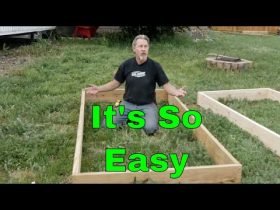

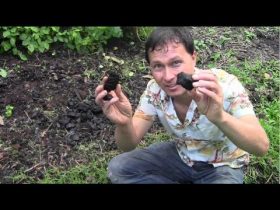
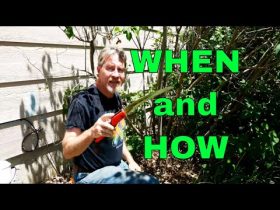

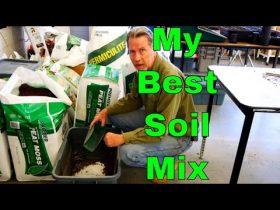
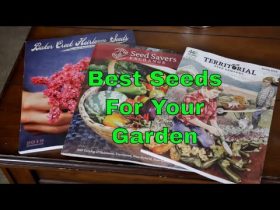
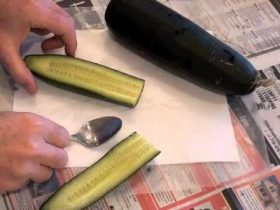


Leave a Reply